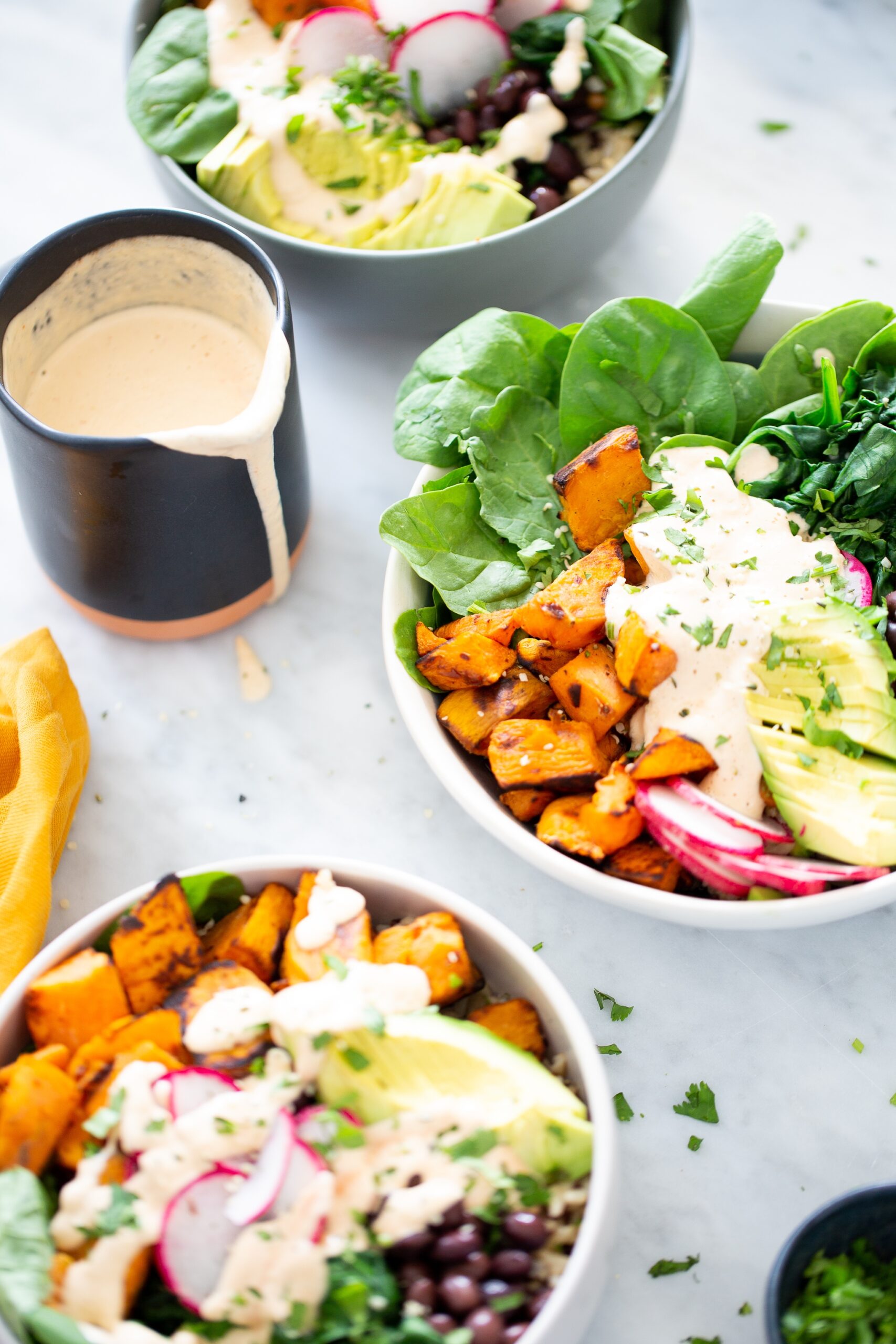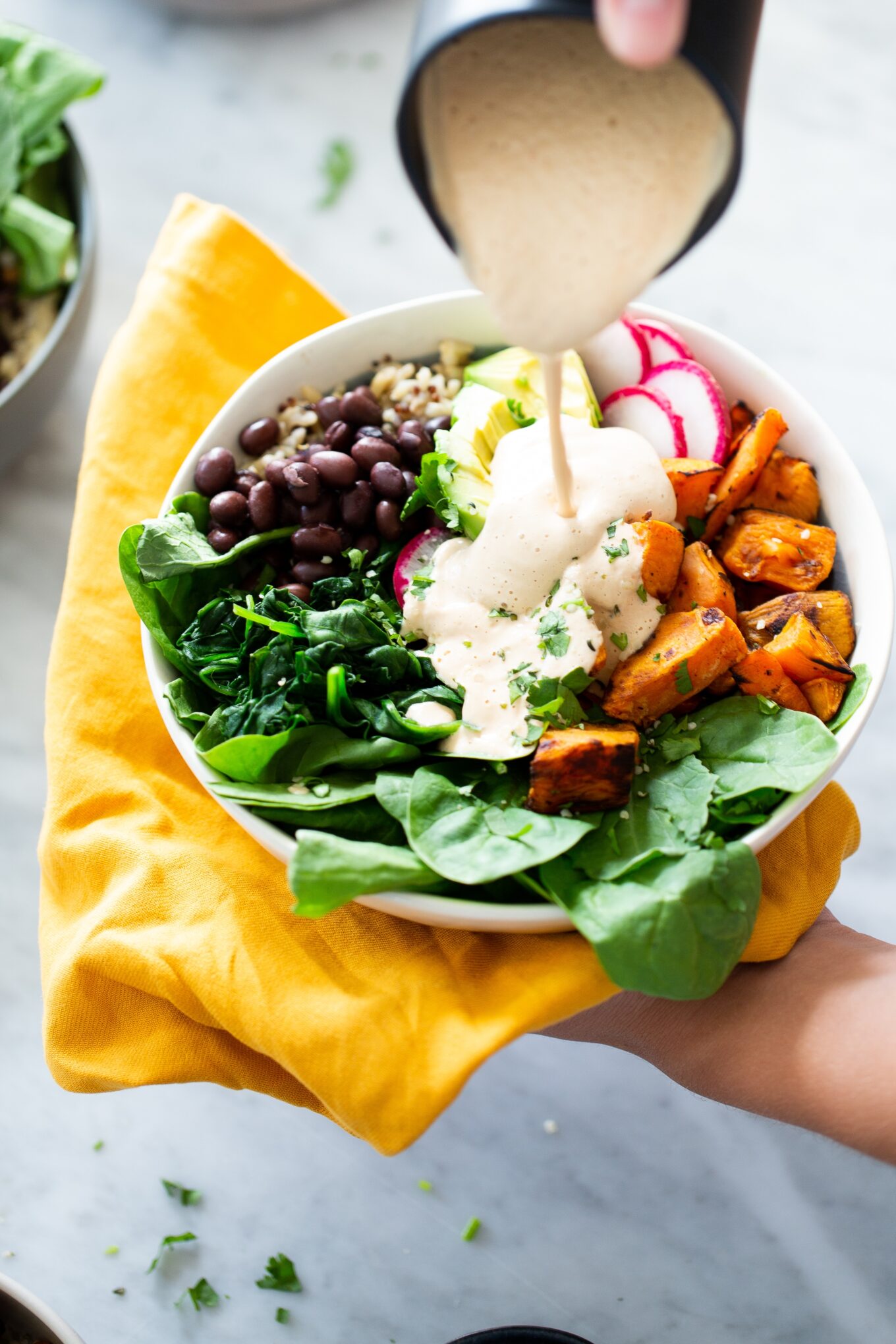A Buddha bowl combines grains, protein sources, and colorful vegetables. A Buddha bowl is a great way to nourish your body and keep you energized throughout the day.

What is a Buddha bowl?
A buddha bowl is a form of grain and veggie bowl. These bowls are popular with your daily nutrients, making them very easy to make. They are filling and will give you energy throughout your day. You can make these in various ways, using almost any vegetable and grain combination.
I first ate a Buddha bowl in Austin, TX, at a restaurant. I ordered it because the name seemed so intriguing to me. I must confess, though, that I had no idea what to expect. But when I first tried it, I fell in love with Buddha bowls. The flavors and textures felt like an explosion in my mouth; I became a massive fan of them then.
The best part is that you can always add a delicious sauce or dressing to enhance its flavor and make it even more enjoyable. Trust me, once you try it, you’ll see why Buddha bowls have become so popular.
Why is it called a Buddha bowl?
Buddha bowl is a balanced meal that may have originated from the Buddhist concept of living a balanced life. A Buddha bowl is a meal that can be devoured. Many people get home after work and don’t have time to prepare an entire meal from scratch, so they turn to these bowls to compose a complete meal in one dish. I love meals like Buddha bowls because you can pack so many nutrients into one meal.
According to Dan Zigmond, a Zen priest and the author of Buddha’s Diet, the name Buddha Bowl might have a very literal origin.
“Buddha woke up before dawn every morning and carried his bowl through the roads or paths wherever he was staying. Local people would place food in the bowl as a donation, and at the end, he would eat whatever he had been given,” he told Epicurious.
That was the original Buddha Bowl: a big bowl of whatever food villagers had available and could afford to share.
How to build a buddha bowl
A Buddha bowl, known for its balanced and nutritious ingredients, typically includes a combination of the following elements. So grab a bowl and start adding your ingredients. Do not forget to finish it with a good drizzle of your favorite dressing.
- Base: A whole grain like quinoa, brown rice, farro, or barley. For a low-carb option, you can use cauliflower rice or spiralized vegetables.
- Protein: Options include grilled chicken, tofu, tempeh, beans, chickpeas, lentils, black beans, or edamame. For non-vegetarians, fish or lean meats can be used.
- Vegetables: A mix of raw, roasted, or steamed vegetables. Common choices are bell peppers, broccoli, carrots, red cabbage, cucumbers, spinach, kale, sweet potatoes, and beets.
- Greens: Leafy greens like arugula, mixed salad greens, spinach, or kale for added nutrients and freshness.
- Healthy Fats: Avocado slices, nuts (like almonds, peanuts, or walnuts), seeds (such as chia, sesame seeds, pumpkin, or sunflower seeds), or olives.
- Dressing: Often a light dressing like tahini sauce, hummus, peanut sauce, Greek yogurt-based sauces, olive oil vinaigrette, or a simple squeeze of lemon or lime.
- Extras: For added flavor and texture, include elements like fresh herbs (cilantro, parsley, mint), sprouts, fermented foods (like kimchi or sauerkraut), or a sprinkle of cheese.
The beauty of a Buddha bowl is its versatility, you do not have to follow a recipe. You can mix and match ingredients based on what you have, your dietary preferences, and your nutritional needs. It’s a great way to enjoy a variety of foods in one balanced meal.
Can this be meal-prepped?
A Buddha bowl can be a fantastic option for meal prep! These bowls are nutritious and versatile, allowing for a wide range of ingredients and flavors. Here’s why they are great for meal prepping:
- Nutrient-Rich and Balanced: Buddha bowls typically include a wholesome balance of vegetables, proteins, and grains, making them a nutrient-packed meal.
- Customizable: You can tailor them to your dietary preferences or whatever ingredients you have. Whether you’re a meat-eater, vegetarian, or vegan, Buddha bowls can be adapted to fit your needs.
- Easy to Prepare in Bulk: You can cook ingredients like grains and proteins in large quantities and then assemble your bowls throughout the week.
- Convenient and Portable: Once assembled, they’re easy to pack and carry, making them ideal for lunches or on-the-go meals.
- Stay Fresh: If you store the components separately, they can stay fresh in the fridge for several days, ensuring you have a quick and healthy meal ready whenever you need it.
Remember to balance your Buddha bowl with a variety of colors and textures to keep your meals interesting and nutritionally diverse. Happy meal prepping!
What is the perfect size for a buddha bowl?
The “perfect” size for a Buddha bowl can vary depending on your dietary needs and appetite, but a good general guideline is to aim for a bowl that holds about 2 to 4 cups (500 ml to 1 liter) of food. This size is typically large enough to accommodate a balanced mix of grains, proteins, vegetables, and other ingredients without being overly large.
Here are a few tips to consider for portioning your Buddha bowl:
- Grains: Start with a base of about ½ to 1 cup of cooked grains. This provides a good foundation without dominating the bowl.
- Proteins: Aim for about ½ to 1 cup of protein, whether it’s plant-based like beans and tofu, or animal-based like chicken or fish.
- Vegetables: Fill at least half of your bowl with a variety of vegetables. This can include a mix of raw and cooked options.
- Greens and Extras: Add a handful of leafy greens and a small amount of extras like nuts, seeds, and dressings for flavor and texture.
- Listen to Your Body: The most important factor is your own hunger and fullness cues. Adjust the portions to suit your personal energy needs.
- Peach Scones: A Delicious and Easy Recipe - July 24, 2024
- Panzanella inspired Pan Fried Gnocchi Salad - July 22, 2024
- Chickpea Vegan Ceviche - July 19, 2024
